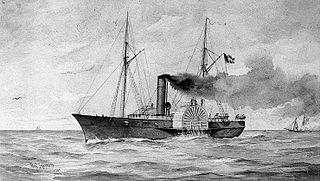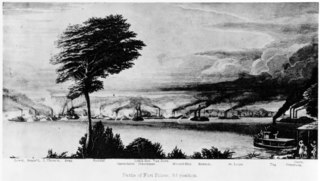See also
- CSS Sumter a Confederate States Navy vessel in the American Civil War
- USS Sumpter a gunboat of the Union Navy.
USS Sumter may refer to the following ships of the United States Navy:

USS Housatonic was a screw sloop-of-war of the United States Navy, gaining its namesake from the Housatonic River of New England.

USS Kearsarge, a Mohican-class sloop-of-war, is best known for her defeat of the Confederate commerce raider CSS Alabama off Cherbourg, France during the American Civil War. Kearsarge was the only ship of the United States Navy named for Mount Kearsarge in New Hampshire. Subsequent ships were later named Kearsarge in honor of the ship.
Six ships of the United States Navy have been named USS Tennessee in honor of the 16th state.
Several ships of the Confederate States Navy have borne the name CSS Georgia, after Georgia:
Sumter may refer to:

CSS Jamestown, originally a side-wheel, passenger steamer, was built at New York City in 1853, and seized at Richmond, Virginia in 1861 for the Virginia Navy during the early days of the American Civil War. She was commissioned by the Confederate States Navy (CSN) the following July, and renamed CSS Thomas Jefferson but was generally referred to as Jamestown, after Jamestown, Virginia.

CSS Nashville was a brig-rigged, side-paddle-wheel passenger steamer that served with the Confederate Navy during the Civil War.
At least three ships of the Confederate States Navy were named CSS Florida in honor of the third Confederate state:

CSS Sumter, converted from the 1859-built merchant steamer Habana, was the first steam cruiser of the Confederate States Navy during the American Civil War. She operated as a commerce raider in the Caribbean and in the Atlantic Ocean against Union merchant shipping between July and December 1861, taking eighteen prizes, but was trapped in Gibraltar by Union Navy warships. Decommissioned, she was sold in 1862 to the British office of a Confederate merchant and renamed Gibraltar, successfully running the Union blockade in 1863 and surviving the war.
John Pope was an officer in the United States Navy during the American Civil War.

The United States Ram Fleet was a Union Army unit of steam powered ram ships during the American Civil War. The unit was independent of the Union Army and Navy and reported directly to the Secretary of War, Edwin M. Stanton. The ram fleet operated in coordination with the Mississippi River Squadron during the Union brown-water navy battle against the Confederate River Defense Fleet for control of the Mississippi River and its tributaries.
Three ships in the Confederate States Navy were named CSS Tennessee

USS Wissahickon was a Unadilla-class gunboat that was built for service with the United States Navy during the American Civil War.
USS Ino was a clipper ship acquired by the Union Navy during the course of the American Civil War. She was capable of great speed and distance, and was a formidable warship with powerful guns.
USS Shepherd Knapp was a large (838-ton) ship with eight guns, purchased by the Union Navy during the beginning of the American Civil War.

USS Sumter was a 525-ton sidewheel paddle steamer captured by the Union Navy during the Union blockade of the American Civil War.

During the American Civil War, blockade runners were used to get supplies through the Union blockade of the Confederate States of America that extended some 3,500 miles (5,600 km) along the Atlantic and Gulf of Mexico coastlines and the lower Mississippi River. The Confederacy had little industrial capability and could not indigenously produce the quantity of arms and other supplies needed to fight against the Union. To meet this need, numerous blockade runners were constructed in the British Isles and were used to import the guns, ordnance and other supplies that the Confederacy desperately needed, in exchange for cotton that the British textile industry needed greatly. To penetrate the blockade, these relatively lightweight shallow draft ships, mostly built in British shipyards and specially designed for speed, but not suited for transporting large quantities of cotton, had to cruise undetected, usually at night, through the Union blockade. The typical blockade runners were privately owned vessels often operating with a letter of marque issued by the Confederate government. If spotted, the blockade runners would attempt to outmaneuver or simply outrun any Union Navy warships on blockade patrol, often successfully.
CSS Admiral has been the name of two Confederate States Navy ships of the American Civil War: